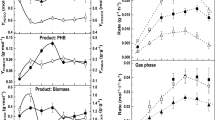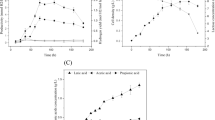Abstract
Biological hydrogen production from synthesis gas was carried out in batch culture. The phototrophic anaerobic bacterium, Rhodospirillum rubrum was used to oxidize CO and water to CO2 and hydrogen. The bacteria were grown under anaerobic conditions in liquid medium; also acetate was used as carbon source in presence of synthesis gas. Biological hydrogen production was catalysed by R. rubrum via the water–gas shift reaction. A light-dependent cell growth modelled with a desired rate of hydrogen production and CO uptake was determined. The effect of light intensity on microbial cell growth was also studied at 500, 1,000 and 1,500 m.cd. A complete conversion of CO to hydrogen and maximum light efficiency were obtained with an acetate concentration of 1 g/l and light intensity of 500 m.cd. Utilization of the carbon monoxide from the gas phase was often considered as a mass transfer limited process, which needed to diffuse through the gas–liquid interface and then further diffuse into liquid medium prior to reaction. The results from this study showed that maximum cell propagation and hydrogen production were achieved with a limited light intensity of 1,000 m.cd. It was also found that high-light intensity may interfere with cell metabolism. In low-light intensity and substrate concentration, no inhibition was observed, however at extreme conditions, non-competitive inhibition was identified. The adverse effect of high-light intensity was shown at 5,000 m.cd, where the CO conversion drastically dropped to as low as 21%. Maximum CO conversion of 98% and maximum yield of 86% with an acetate concentration of 1.5 g/l and a light intensity of 1,000 m.cd were achieved.
Similar content being viewed by others
Abbreviations
- A :
-
Irradiated area (m2)
- \( C_{{\text{T}}_0 } \) :
-
Initial total moles of gas (mmol)
- C Ac, (t=0) :
-
Initial acetate concentration (g/l)
- C CO :
-
Moles of CO (mmol)
- C CO,0 :
-
Initial moles of CO (mmol)
- \(C_{{\text{H}}_2 } \) :
-
Moles of hydrogen (mmol)
- \( C_{{\text{H}}_{2,0} } \) :
-
Initial moles of hydrogen (mmol)
- I :
-
Light intensity [m.cd (lux)]
- k CO :
-
First-order rate constant of CO (h−1)
- k Ac :
-
First-order rate constant of acetate (h−1)
- K I :
-
Monod constant based on light intensity (m.cd)
- \( k_{{\text{H}}_2 } \) :
-
Rate constant of hydrogen (mmol−1/h−1)
- m.cd :
-
Meter-candela
- nCO(t=0) :
-
Initial moles of CO (mmol)
- \( n_{{\text{H}}_2 (t = 0)} \) :
-
Initial moles of H2 (mmol)
- \( n_{{\text{T}}_0 } \) :
-
Total moles (mmol)
- t :
-
Time (h)
- x 0 :
-
Cell dry weight (g/l)
- x m :
-
Maximum cell dry weight (g/l)
- X CO :
-
CO conversion (%)
- \( Y_{{\text{H}}_2 {\text{/CO}}} \) :
-
Yield of hydrogen based on CO
- μ :
-
Specific growth rate (h−1)
- μ m :
-
Maximum specific growth rate (h−1)
- μ mI :
-
Maximum specific growth rate based on light intensity (h−1)
- η L :
-
Light efficiency (%)
References
Akkerman I, Janssen M, Rocha J, Wijffels RH (2002) Photobiological hydrogen production: photochemical efficiency and bioreactor design. Int J Hydrogen Energy 27:1195–1208
Bailey JE, Ollis DF (1986) Biochemical engineering fundamentals, 2nd edn. McGraw Hill, New York (ISBN 0-07-003212-2)
Barbosa MJ, Rocha JMS, Tramper J, Wijffeles RH (2001) Acetate as carbon source for hydrogen production by photosynthetic bacteria. J Biotechnol 85:25–33
Eroglu E, Gunduz U, Yucel M, Turker L, Eroglu I (2004) Photobiological hydrogen production by using olive mill wastewater as sole substrate source. Int J Hydrogen Energy 29:163–171
Ghirardi ML, Kosourov S, Tsygankov A, Seibert M (2000) Two-phase photobiological algal H2-production system. In: Proceedings of DOE hydrogen program review NREL/CP-570-28890
Grima EM, Camacho FG, Perez JAS, Sevilla JMF, Fernandez FGA, Gomez AC (1994) A mathematical model of microalgal growth in light limited chemostat culture. J Chem Technol Biotechnol 61:167–173
Jung YG, Kim JR, Park JY, Park S (2002) Hydrogen production by a new chemoheterotrophic Bacterium Citrobacter sp. Y19. Int J Hydrogen Energy 27:601–610
Klasson KT, Lundback KMO, Clausen EC, Gaddy GL (1993) Kinetics of light limited growth and biological hydrogen production from carbon monoxide and water by Rhodospirillum rubrum. J Biotechnol 29:177–188
Koku H, Eroglu I, Gunduz U, Yucel M, Turker L (2002) Aspect of the metabolism of hydrogen production by Rhodobacter sphaeroides. Int J Hydrogen Energy 27:1315–1329
Koku H, Eroglu I, Gunduz U, Yucel M, Turker L (2003) Kinetics of biological hydrogen production by the photosynthetic bacterium Rhodobacter sphaeroides O.U. 001. Int J Hydrogen Energy 28:381–388
Kondo T, Arakawa M, Wakayama T, Miyake J (2002) Hydrogen production by combining two types of photosynthetic bacteria with different characteristics. Int J Hydrogen Energy 27:1303–1308
Lide DR (1992) CRC handbook of chemistry and physics, 72nd edn. CRC Press, Boston, USA, pp 1–27
Miyake J, Miyake M, Asada Y (1999) Biotechnological hydrogen production: research for efficient light energy conversion. J Biotechnol 70:89–101
Najafpour GD, Younesi H, Mohamed AR (2004a) Effect of organic substrate on hydrogen production from synthesis gas using Rhodospirillum rubrum, in batch culture. Biochem Eng J 21:123–130
Najafpour GD, Younesi H, Ku-Syahidah KI, Mohamed AR, Harun Kamaruddin A (2004b) Performance of biological hydrogen production process from synthesis gas, mass transfer in batch and continuous bioreactors. Int J Eng 17(2):105–120
Najafpour GD, Younesi H, Mohamed AR (2003) Continuous hydrogen production via fermentation of synthesis gas. Int J Petrol Process, Petrochem Coal Process 45:154–158
Najafpour GD, Basu R, Clausen EC, Gaddy GL (1995) Water–gas shift reaction for synthesis gas: a biological route. Int J Eng Sci, Iran Univ Sci Technol 6:39–49
Nakada E, Nishikada S, Asada Y, Miyake J (1999) Photosynthetic bacterial hydrogen production combined with fuel cell. Int J Hydrogen Energy 24:1053–1057
Ogbonna JC, Yada H, Tanaka H (1995) Kinetic study of light-limited batch cultivation of photosynthetic cells. J Ferment Bioeng 80:259–264
Pelczar MJ Jr, Chan ECS, Krieg NR (1993) Microbiology, 6th edn. McGraw Hill, New York (ISBN 0-07-0429234-4)
Perry RH, Green DW (1997) Perry’s chemical engineer’s handbook, 7th edn. McGraw Hill, New York (ISBN 0-07-049841-5)
Wakayama T, Miyake J (2002) Light shade bands for the improvement of solar hydrogen production efficiency by Rhodobacter sphaeroides RV. Int J Hydrogen Energy 27:1495–1500
Weaver PF, Lien S, Seibert M (1980) Photobiological production of hydrogen. Solar Energy 24:3–45
Winkler M, Hemschemeier A, Gotor C, Melis A, Happe T (2002) [Fe]-hydrogenases in green algae: photo-fermentation and hydrogen evolution under sulphur deprivation. Int J Hydrogen Energy 27:1431–1439
Zhu H, Wakayama T, Asada Y, Miyake J (2001) Hydrogen production by four cultures with participation by anoxygenic photosynthetic bacterium and anaerobic bacterium in the presence of \( {\text{NH}}_4^ + \) . Int J Hydrogen Energy 26:1149–1154
Acknowledgements
The present research was made possible through an IRPA grant No. 03-02-05-9016, sponsored by Ministry of Science, Technology and Innovations (MOSTI), Malaysia and Universiti Sains Malaysia (USM). The authors wish to thank RCMO panels, Universiti Sains Malaysia and MOSTI for their financial support.
Author information
Authors and Affiliations
Corresponding author
Rights and permissions
About this article
Cite this article
Najafpour, G.D., Younesi, H. Bioconversion of synthesis gas to hydrogen using a light-dependent photosynthetic bacterium, Rhodospirillum rubrum. World J Microbiol Biotechnol 23, 275–284 (2007). https://doi.org/10.1007/s11274-006-9225-2
Received:
Accepted:
Published:
Issue Date:
DOI: https://doi.org/10.1007/s11274-006-9225-2




